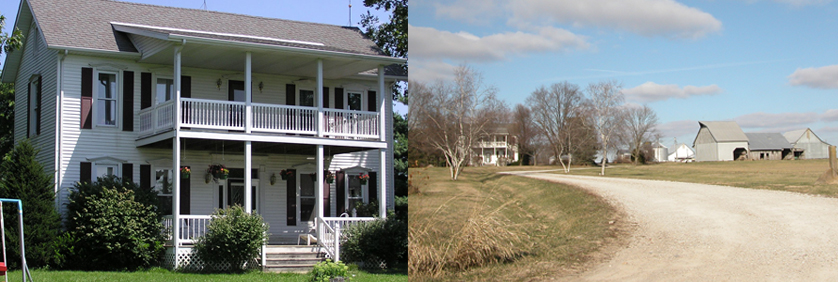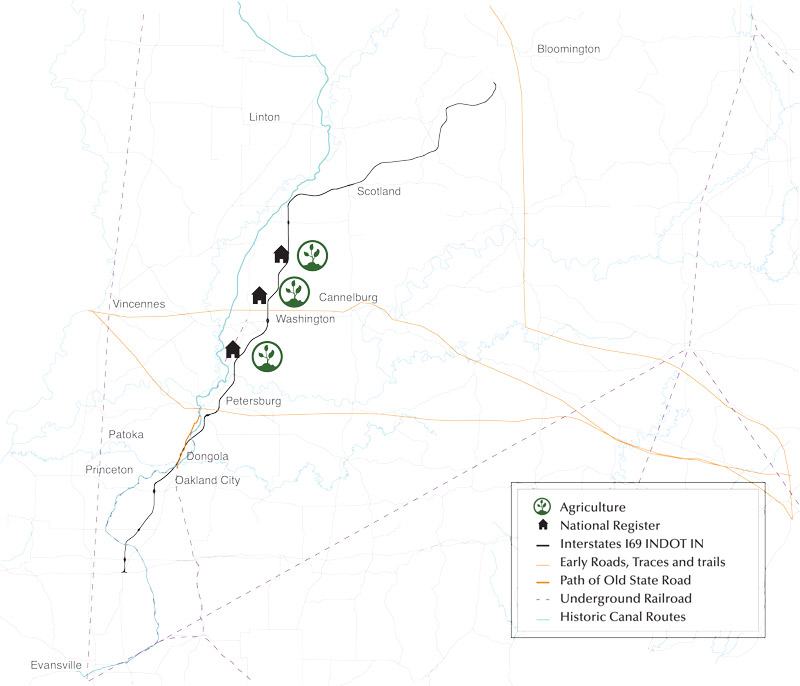As you "Travel I-69," you cross vast expanses of Hoosier farmland, punctuated by cylindrical silos, red and white barns, and farmhouses set amidst fields of crops and pastures. "Agriculture" is one of a series of vignettes that recounts the story of the land between I-64 and Bloomington, Indiana. Choose one or all of the vignettes to learn about the cultural and natural landscape as you Travel I-69.
A map provides locational information and the following narrative discloses the names of towns and interchanges where these historic activities have occurred. Observe the following landmarks: the McCall Family Farmstead at Mile Marker 71 and the Pleasant Hill Farm where I-69 and State Road 37 join.
A Hoosier homemaker in southwestern Indiana provides insight into rural life nearly a century ago:
He had to work hard. Yes, but I had to work hard, too. I always had all the milking and I made a big garden and I had all them kids to take care of. And we farmed in the summer and I had to get up early and plow with the team before it got too hot. Oh, how I hated to get up.
—Grace Hawkins, 93, Martin County1
- Read More

Left: McCall Family Farmstead in Daviess County, Indiana (Weintraut & Associates, Inc.)
Right: Lane leading to the McCall Family Farmstead near Mile Marker 71 (Weintraut & Associates, Inc.)The land along I-69 was first cleared by settlers to create fields for crops used to sustain their families in the wilderness. These first settlers used the cleared timber to build log homes for themselves and barns for their animals. Within a generation, small subsistence farms gave way to larger farms, as families increased their acreage and harvests with surpluses that could be sold at market.[1]
In Daviess County, the McCall family (consisting of William, Margaret, and their seven children) started a small twenty-acre farm in the 1850s. Like many of their neighbors, they expanded the farm by acquiring additional land until it reached 180 acres by 1860.[2]
Hoosier farm families like the McCalls enjoyed unprecedented affluence between 1880 and 1920, a prosperous period for farmers in the Midwest and Indiana. In fact, the latter two decades are commonly identified as the "golden age" of agriculture in the state. Production increased, and, especially after 1900, prices of farm products rose. Innovations in machinery helped increase production in the fertile lowlands. It was during this era that many of the Hoosier farmsteads we see were being built.[3]
These farms usually displayed a picturesque Queen Anne or Italianate farmhouse and numerous farm buildings, each with a specific purpose. Summer kitchens, pumps or pumphouses, and windmills were located near the farm house; barns, other livestock buildings, and tool sheds were located farther from the house.[4] The McCall family replaced their small log home with a modern Italianate farmhouse by 1883. Other outbuildings on their farm included three large barns dating from the late nineteenth century to early twentieth century, a pumphouse, and a garage.[5]
Large barns were used for storage and repair of the farm’s growing inventory of machinery and tools, as well as for housing animals. The "big barn," sometimes with a silo next to it, became a mainstay of the Hoosier landscape.[6]
By the 1920s, many families, including the McCalls, were expanding dairy operations and building or remodeling barns for this purpose.[7] In many areas, farmers raised cattle, hogs, sheep, chickens, horses, and mules. Even as late as 1920, horses and mules accounted for the motive power on most farms in Indiana. For much of the state, horses were used more often than mules, except in southwestern Indiana where mules were more often in the field.[8]
Almost every farm wife had her own orchard for fruit and garden for vegetables. Few town lots were without a garden and a fruit tree or two. However, with the introduction of the canning industry in Indiana around the turn of the century, fruits and vegetables, especially tomatoes, corn, and peas, began to be grown for a larger market.[9] Life on the farm could be difficult and some farm wives, including Tilly Pearl McCall, supplemented the family’s income by raising chicks and eggs for market.[10]
The "big barns" and the large farmhouses as well as windmills, smoke houses, and summer kitchens have made an indelible mark on the Hoosier landscape. Look for them in your travels through Indiana.
[1] M. Teresa Baer, Kathleen Breen, and Judith McMullen, Centennial Farms of Indiana (Indianapolis: Indiana Historical Society Press, 2003), 17-18.
[2] Weintraut & Associates, Inc., “McCall Family Farmstead,” National Register of Historic Places Nomination Form, 2013, 10.
[3] Clifton J. Phillips, Indiana in Transition: The Emergence of an Industrial Commonwealth, vol. 4, History of Indiana (Indianapolis: Indiana Historical Society, 1968), 132-133; Baer, et al, Centennial Farms of Indiana, 22-23.
[4] Weintraut & Associates, Inc., “Section 106 Report,” I-69: Evansville to Indianapolis Tier 1 Study, prepared for Federal Highway Administration and the Indiana Department of Transportation, October 2003, 56-57.
[5] Weintraut & Associates, Inc.,“McCall Family Farmstead,” 3-5, 12.
[6] Glenn A. Harper and Steve Gordon, “The Modern Midwestern Barn: 1900 – Present,” in Barns of the Midwest, Allen G. Noble and Hubert G. H. Wilhelm, Eds. (Athens, OH: Ohio University Press, 1995), 214-215.
[7] Weintraut & Associates, Inc., “McCall Family Farmstead,” 12.
[8] Clifton J. Phillips, Indiana in Transition: The Emergence of an Industrial Commonwealth, vol. 4, History of Indiana (Indianapolis: Indiana Historical Society, 1968), 164-165.
[9] Phillips, Indiana in Transition, 154–57.
[10] Weintraut & Associates, Inc., “McCall Family Farmstead,” 12.
Historic Agricultural Sites In Southwestern Indiana

